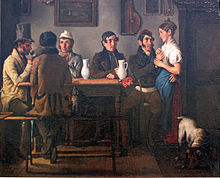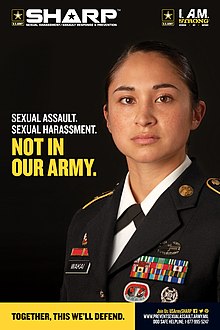Sexual harassment
unwanted sexual attention or advances From Wikiquote, the free quote compendium


Sexual harassment is bullying or coercion of a sexual nature and the unwelcome or inappropriate promise of rewards in exchange for sexual favors. Sexual harassment includes a range of actions from mild transgressions to sexual abuse or sexual assault.
| This theme article is a stub. You can help out with Wikiquote by expanding it! |
Quotes
- The former head of an Orthodox Jewish neighborhood watch group pleaded guilty on Friday to charges that he forced a troubled 15-year-old girl to have sex. Brooklyn Shomrim leader Jacob Daskal, 64, avoided trial in Brooklyn Federal Court on allegations he groomed the underage girl and transported from Brooklyn across the state line to New Jersey and then upstate, where he assaulted her at his vacation home and at a campground. As part of his guilty plea, Daskal agreed to a sentence within the range of 14 to 17 years in jail. He is also required to register as a sex offender. The exact details of his sentence will be determined at a future hearing.
- Most men know what sexual harassment is, and most women know what it is. The idea that men don’t know their behavior is bad and that women are making a mountain out of a molehill is largely untrue. If anything, women are more lenient in defining harassment.
- Leanne Atwater, as qtd. in Tim Bower, “The #MeToo Backlash”, Harvard Business Review, September-October 2019 as qtd. in Arwa Mahdawi, “Men now avoid women at work – another sign we're being punished for #MeToo”, The Guardian, (29 Aug 2019).
- The researchers have several recommendations for organizations looking to reduce harassment, a number of which involve prevention training. Their study shows that traditional sexual harassment training has little effect, perhaps because much of it focuses on helping employees understand what constitutes harassment, and the data shows they already do. Instead, the researchers say, companies should implement training that educates employees about sexism and character. Their data shows that employees who display high levels of sexism are more likely to engage in negative behaviors, and they believe training can reduce those levels. Their data also shows that people of high character—those who display virtues such as courage—are less likely to harass and more likely to intervene when others do. “Though character building in organizations is on the cutting edge and consultants are just learning how to do this, there are training resources available,” the researchers write.
- “Looking Ahead: How What We Know About Sexual Harassment Now Informs Us of the Future,” by Leanne E. Atwater, Allison M. Tringale, Rachel E. Sturm, Scott N. Taylor, and Phillip W. Braddy (Organizational Dynamics, forthcoming); as summarized in Tim Bower, “The #MeToo Backlash”, Harvard Business Review, September-October 2019; as qtd. in Arwa Mahdawi, “Men now avoid women at work – another sign we're being punished for #MeToo”, The Guardian, (29 Aug 2019).
- I have watched the #metoo campaign as avidly as anyone. I have gone to bed each night wondering who will be outed as a sexual harasser in the morning, whether it will be another one of my political heroes or someone we all recognize from mainstream media or Hollywood. We’ve seen many of these perpetrators lose jobs, be forced to resign, and face economic difficulty because of their abhorrent behaviors.
But I have not gone to bed a single night in all these months wondering what scientist would be sacked in the morning because of his transgressions—let alone be publicly outed—because scientist-harassers rarely lose their jobs.
- Kathryn B. H. Clancy, "Have the Sciences Had a #MeToo Moment? Not So Much.", National Geographic, (05/2018).
- Too often the story is the same: A man sexually harasses a woman, the woman reports it, and she gets told that’s just how it is.
- Kathryn B. H. Clancy, "Have the Sciences Had a #MeToo Moment? Not So Much.", National Geographic, (05/2018).
- When part of your brain has to be occupied with workplace stress—from unwanted sexual advances to witnessing abuse between colleagues—you have less to give to your science.
- Kathryn B. H. Clancy, "Have the Sciences Had a #MeToo Moment? Not So Much.", National Geographic, (05/2018).
- Racism may well provide the clarity to see that sexual harassment is neither a flattering gesture nor a misguided social overture but an act of intentional discrimination that is insulting, threatening, and debilitating.
- Kimberlé Williams Crenshaw, Whose Story is it Anyway?: Feminist and Antiracist Appropriations of Anita Hill, supra note 107, at 402, 412.
- Studio heads and producers have been relatively quick to welcome back actors, directors, and writers who’ve been accused of harassment and assault, particularly when their status makes them seem irreplaceable. It’s a dual-edged message: Don’t abuse your power, but if you do, you’ll still have a career. Part of the confusion comes down to the fact that these men are seen as invaluable because the stories they tell are still understood to have disproportionate worth. When the slate of new fall TV shows is filled with father-and-son buddy-cop stories and prison-break narratives and not one but two gentle, empathetic examinations of male grief, it’s harder to imagine how women writers and directors might step up to occupy a sudden void. When television and film are fixated on helping audiences find sympathy for troubled, selfish, cruel, brilliant men, it’s easier to believe that the troubled, brilliant men in real life also deserve empathy, forgiveness, and second chances. And so the tangible achievements one year into the #MeToo movement need to be considered hand in hand with the fact that the stories being told haven’t changed much at all, and neither have the people telling them. A true reckoning with structural disparities in the entertainment industry will demand something else as well: acknowledging that women’s voices and women’s stories are not only worth believing, but also worth hearing. At every level.
- Sophie Gilbert, “The Men of #MeToo Go Back to Work“, The Atlantic, (Oct 12, 2018).
- President Moon and the DP's silence on and apparent unwillingness to get to the bottom of the sexual harassment allegations directed at powerful heads of local government, including the highly influential Seoul Mayor Park Won-soon, is yet another example of their desire to make abuse of power and impunity the new norm in South Korea.
- In Australia, the Human Rights and Equal Opportunity Commission specifically lists the display of pin-ups as an example of sexually harassing behaviour. While sexual harassment legislation in both Australia and the United States covers sites including workplaces and educational institutions, such legislation has not been designed to include sexual harassment occurring in public space. This article will explore the reality that outdoor advertisements on public display are visually very similar to sexually harassing pin-ups, as will be demonstrated through references to examples collected as part of a year long study of outdoor advertising in Melbourne, Australia. Because of the visual similarities between outdoor advertising and, for example, pin-ups which are prohibited in sites such as workplaces, this article suggests that both media should be critiqued in the exact same manner. This article argues that the specific elements that make sexual harassment inappropriate in the workplace – i.e., the captive environment that is created whereby exposure to sexual images is unavoidable – is a situation replicated in public space with a person utilising space being held captive in a similar manner. Similarly, this article will explore the manner in which pin-ups masculinise a workplace in the same way that sexist outdoor advertisements masculinise public space. The usefulness, limitations and feasibility of the application of sexual harassment discussions to sexist outdoor advertisements will also be considered.
- Rosewarne, L. (2007). "Pin-ups in public space: Sexist outdoor advertising as sexual harassment", Women’s Studies International Forum, 30, p. 313.
- "I don't understand guys who whisper 'mashallah' in your face ... like what is this, halal harassment?"
- Twitter user @RBalli_ [1]
- "Saying Mashallah does not make your harassment halal"
- Placard in [{Aurat March]] 2020 [2]
See also
External links
- ↑ https://stepfeed.com/this-arab-girl-shut-down-halal-harassment-in-the-most-savage-way-1194 (Similar slogan latter appeared in Aurat March 2020)
- ↑ https://www.geo.tv/latest/276444-the-men-of-aurat-march-and-their-posters www.geo.tv. Retrieved 31 March 2020
Wikiwand - on
Seamless Wikipedia browsing. On steroids.
